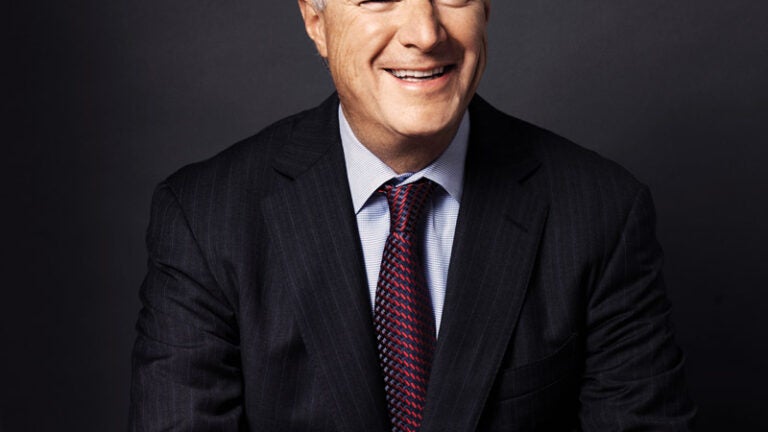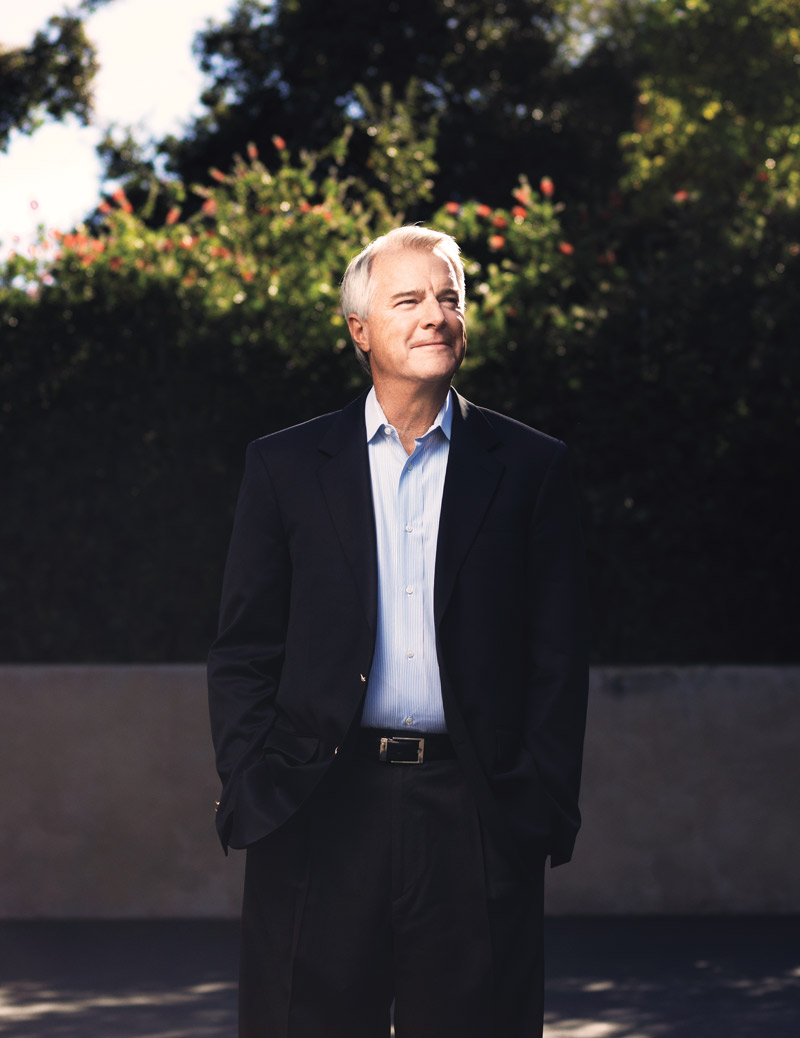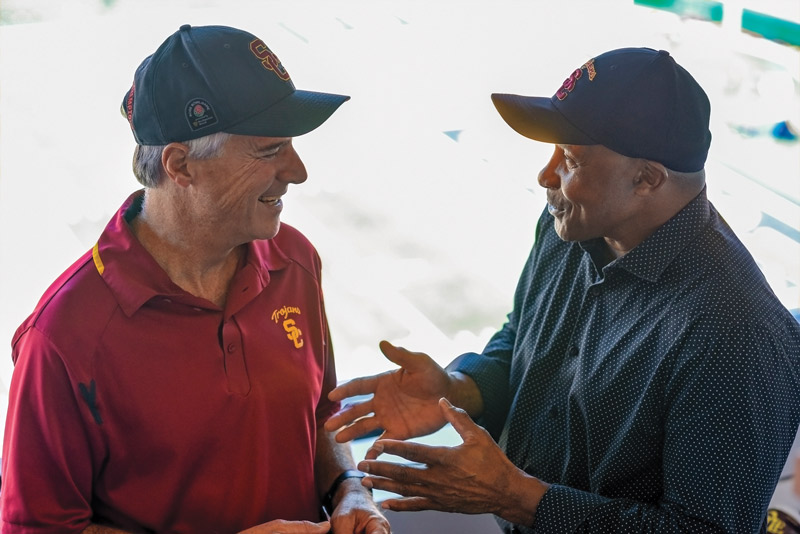
(Photo/Cody Pickens)
Mark Stevens’ Trojan Success Story
The USC trustee has invested to create a better world, and he and his wife, Mary, have donated more than $100 million to grow USC.
C. L. Max Nikias was this close to taking an early flight home to Los Angeles. For a week, Nikias—an electrical engineering professor at USC—had marched diligently through the offices of Silicon Valley computer firms from Mountain View to San Jose. It was May 5, 1995, and the digital media and internet revolution had begun. While Cinco de Mayo revelers were tilting back happy-hour margaritas in Palo Alto bars on a late Friday afternoon, Nikias was still working on the last leg of his week-long trip.
He was trying to recruit tech company leaders to write letters supporting USC’s underdog effort to win federal funds for an integrated media systems innovation center on campus.
The exhausted professor couldn’t bear to trudge to one more boardroom. He had never met the last man on his schedule: Mark Stevens ’81, MS ’84, a 35-year-old venture capitalist and USC engineering alumnus. Let’s skip the meeting, Nikias told a staff member.
“I know this is not a corporation, this is not the CEO of a company,” Nikias remembers the staff member replying. “We’re probably not going to get a letter from Mark Stevens, because he’s a VC, but he’s got a whole network of contacts. He knows so many other CEOs and companies.”
So instead of heading to the airport, Nikias walked into a modest conference room in Sequoia Capital’s Menlo Park office. What he found was a welcoming man wearing jeans, a polo shirt, sneakers and an unpretentious smile.
As it turns out, Stevens was happy to help. He signed up more than a dozen tech firms to back USC. But the meeting would come to have a far greater impact on USC than snatching a National Science Foundation grant away from rivals UC Berkeley and Columbia University. It would mean more than Nikias could ever have imagined.

BECOMING A TROJAN
Today Stevens and Nikias laugh about the memory.
“I think we were scheduled for an hour-long meeting, and we spent two hours together,” Stevens says of that day. After he graduated from USC in 1981, he had stayed in touch with his fraternity brothers and, like many USC football fans, donated to Cardinal & Gold. But that 1995 appointment was his reintroduction to the USC Viterbi School of Engineering and to the university.
Since then, Nikias has become USC president, and Stevens has parlayed his analytical prowess, engineering knowledge and business acumen into a net worth said to be in the billions. He was a managing partner of Sequoia Capital until 2012, and is now managing partner at his family office, S-Cubed Capital. Stevens also has served as a USC leader for nearly 17 years, joining the USC Board of Trustees in 2001. He was the university’s youngest trustee for much of his tenure.
Nikias and Stevens have worked on projects and sat together at USC football games, through frustrating losses (“before the Pete Carroll era,” Nikias says) and dominant wins enjoyed in the rain.
Their mutual respect may stem from their shared desire to seize opportunities and build results. They’re also both electrical engineers. “We both come from humble beginnings,” Nikias says, “so that keeps us grounded.”
“The great thing about being a venture capitalist is you get to see the future. You get to see around corners, because you’re backing entrepreneurs who are seeing the future.”
Mark Stevens
That brings us to how Stevens first arrived at USC.
When he was considering colleges, USC was the obvious choice: It had a strong engineering school and he could attend without saddling his parents with debt, thanks to scholarships and grants he had cobbled together. USC also was nearby and familiar. He grew up about 10 miles away from campus on the edge of Culver City, a then-untrendy Westside enclave heavy with middle-class defense and entertainment industry employees. His first job was at a Jack in the Box.
In many ways, his parents were typical of Culver City in the 1960s and 70s. Neither had attended college, but they earned enough. They supported their children’s education at good local public schools, and it was a happy home. Stevens’ father learned electronics through the U.S. Navy and became an electronics test engineer at Hughes Aircraft, while his mom, a child of Italian immigrants, was a secretary. The elder Stevens repaired broken televisions as a side gig; he met his future wife when he visited her parents’ home on a house call.
The couple couldn’t lavish expensive gifts or globe-trotting trips on young Mark and his sister, but they provided love, solid values and time together. He emphasizes this, in part, because he and his sister, Lisa, a 1983 USC Marshall School of Business graduate, were adopted. He says it in a matter-of-fact way, and moves on.
It’s telling that he embraces his adoption with practicality. The only reason he would investigate his birth parents’ identities, he says, is to get health information to share with his doctor. It’s a reflection of the logical, systematic orientation of an engineer. Not that he’s driven by cold facts and numbers, though.
“I’m analytical, but I don’t let analytics drive everything,” he says. Take his interest in sports, for example. As a basketball fan and now a minority owner of the Golden State Warriors, he’s intrigued by sports analytics, but he refuses to let statistics overshadow his enjoyment of the game itself. The game is where the thrill is.
And this begins to get at the root of his success.
HIGH-TECH’S GROUND FLOOR
Academic success started early for Stevens. In the middle of first grade, he was so bored that his parents had the school move him to second. He read book after book and was fascinated by maps. At Culver City High School, he took so many Advanced Placement courses and junior college classes that he earned enough credits to add economics as a second USC undergrad major, besides electrical engineering.
From the beginning, he wanted not to be just a technical wizard or a coder, but instead, to have a 360-degree view of the world. “That’s where non-engineering subjects are super important,” he says. “What USC has done with encouraging students to do a minor or a second major in a different field is wonderful.”
Skipping a grade meant that he was shorter and skinnier than his peers in high school, and that he started USC only six months after his 17th birthday. College was the time to catch up, in both size and maturity. Good friend Kurt English, a fellow electrical engineering major, had rushed Phi Kappa Psi freshman year and urged him to try it. For someone eager to grow beyond the “intense” world of engineering, the fraternity opened doors.
Even at Phi Psi, Stevens balanced school and social life with precision. Saturdays were dedicated to football and the “kind of crazy” guys in his house, while Sundays transformed him into a silent monk, hammering out engineering problem sets. Rest breaks grew even more precious when he started working at Hughes Aircraft 20 hours a week in exchange for tuition, but that work experience also served up the first of his many risk-reward choices after graduation.
“I don’t want to be an aerospace engineer at a big aerospace company for the rest of my life, like Dad.” That’s what Stevens remembers thinking when he decided to trade the stability of Hughes for a technical sales position at an upstart company called Intel. Look beyond safe solutions and the simple lure of a paycheck, he tells young people today. Take calculated risks.
He took a pay cut to go to Intel, but it would be worth it.
As the personal computer industry grew quickly, so did Intel, along with Stevens’ standing at the microprocessor company. But the great market potential lay in software, he sensed. Needing to boost his knowledge and adapt, he turned again to USC’s engineering school. Night classes offered remotely through the school’s Distance Education Network netted him a master’s in computer engineering. Within a few years, he returned to school again—this time at Harvard—and earned his MBA in 1989. That set up another major decision.
MBAs tended to work as consultants or investment bankers, Stevens says, but neither was the right fit for him. Then there was Intel, and going back there would be just that: going backward. So he scanned the landscape, homed in on part of the tech world with the biggest growth potential and started writing letters to the people who were investing in it. Did any Silicon Valley venture capital firms need the expertise of an MBA who spoke the language of semiconductors and microprocessors?
Enter Sequoia Capital.
THE TROJAN GOES NORTH
Sequoia, a Menlo Park-based firm that invested in early-stage tech companies, paid less than Intel. Gone were the sales commissions and company car.
It was another gamble.
“At that point in time, the venture industry was sort of small by today’s comparisons, or even by the dot-com boom’s comparisons,” Stevens says. The stock market had just crashed, recession was on the way and plucky venture capitalists were pooling resources to invest. But as he notes, “the best investors, not just in the venture world, but across all different asset classes, are counterintuitive thinkers, and they look for opportunities when others don’t see them or don’t want to.”
As Stevens was learning the business, Sequoia had backed two “little” companies that went public: Cisco and Electronic Arts. They were harbingers of what was to come. Soon Stevens was sit-ting with the founders of Yahoo! in their Stanford bungalow as they shared their plan to make a table of contents for the internet. They had no idea how they’d make money, but Sequoia bet on them anyway. Companies like Google would follow.
He was involved in the birth of semiconductor giant Microchip Technology, which grew out of a buyout of a division of General Instrument. Stevens nurtured the spinoff, recommending new leadership and dealing with legacy business. (“The previous CEO was a 6-foot-5 Texan who kept a loaded gun in his desk in his office,” he says.)
Another point of personal pride is prominent chip-maker NVIDIA, where he still sits on the board. He has served as a director at many startups that became big acquisitions.
That’s not to say failure eludes him. His first investment at Sequoia tanked, losing millions. It’s investors’ money, so it’s nothing to laugh about, he says, “but if you run into a venture capitalist who says, ‘I’ve never lost money,’ then one of two things is happening. One, they’re lying, or two, they’re not taking enough risk in their portfolio.”
Yes, take risks, but don’t take foolish risks. That’s where Stevens’ brand of analytics with a holistic perspective comes in.
To invest, he looks for startups born at the right time: They’re meeting a need for a big enough market, right when that market is poised for growth.
He refers to this ability to understand emerging trends, recognize a market and predict the market’s timing as “seeing around the corner.”
“The great thing about being a venture capitalist is you get to see the future,” he says. “You get to see around corners because you’re backing entrepreneurs who are seeing the future. Entrepreneurs, by their nature, are iconoclastic. They’re different. They’re weird. They see things that 99 percent of the population doesn’t see.”
To decide whether to invest in a venture or field, Stevens reads books. Magazines. Articles online. He survives on six hours of sleep a night partly because he consumes information so voraciously. All of those data points whirl together to create in-formed intuition—the ultimately human hunches that have led to exhilarating business gambles worth millions of dollars.
The wins.
INVESTING IN USC
More than 300 miles south of Menlo Park, in a glass-walled research center on the USC Health Sciences Campus, eminent USC neuroscientist Art Toga mulls over how he’d describe Stevens.

“He’s analytical, but in his own experiential way,” Toga says. “In areas that are not quantifiable, he compares elements from prior experiences to take a leap. There’s an art to that.”
Toga has gotten to know Stevens in the last two years: In 2015, Stevens and his wife, Mary, donated $50 million to name the USC Mark and Mary Stevens Neuroimaging and Informatics Institute, which Toga directs.
The institute works to demystify the brain, one of the last, most puzzling frontiers of medicine. Both men share a personal interest in brain disease; Stevens’ father and Toga’s mother, aunt and grandmother are among the millions hit by Alzheimer’s.
With high-profile research findings and brain imaging technology found in few other places, the institute stands out internationally. Toga praises Stevens’ approach to his gift as an investment in the institute’s leadership—just as he would a promising business. The investor stays involved, checking on progress and inquiring about scientific approaches, but never too much.
“He has made the program possible,” Toga says. “If I want to build the program and take it even further, I need to be able to attract the best talent in the world. I have to be able to put a package on the table to entice sought-after researchers. He has enabled that.”
Starting with his first gift of $100 in 1993 and that first meeting with Nikias in Silicon Valley, Stevens has grown ever closer to USC over a quarter of a century. He has volunteered countless hours to boards across USC, including the USC Health System Board, and has spoken at student events and taught classes. He co-chaired USC Viterbi’s fundraising initiative in the early 2000s when Nikias was the school’s dean, and he continues to provide financial support, giving more than $100 million to the university at last count.
Mark and Mary Stevens’ giving stretches across the University Park and Health Sciences campuses, touching many areas of the university. They believe in nurturing students’ spiritual life, so they gave generously to help create the USC Caruso Catholic Center. And as a big USC Trojans supporter, Stevens believes great athletes can also be great students. He donated $10 million to establish the Stevens Academic Center, which supports student-athletes’ success in school.
Among Stevens’ beneficiaries is the USC Stevens Center for Innovation, USC’s technology transfer office, which he founded with a $22 million gift in 2004. Jennifer Dyer, the center’s executive director, notes that Stevens’ guidance on tech transfer has helped make the Stevens Center more business savvy, helping to significantly grow the number of licenses of USC-owned technology and almost doubling the university’s intellectual property income.
She also praises Stevens for his warmth and for always having time to mentor others and share expertise. Last year, he spoke to young USC entrepreneurs at the center’s Student Innovator Showcase, she says, sharing technology trends and encouraging them to “be curious, be passionate, be thoughtful and be fair. Most importantly, have fun along the way.”
Stevens’ openness and accessibility inspires students and faculty who want to pursue their own startups, says Yannis Yortsos, dean of USC Viterbi, who notes that Stevens has helped the school develop new activities surrounding innovation and entrepreneurship. He also has contributed toward a USC Viterbi venture fund designed to invest money in USC-related startups and then reinvest returns into the university.
The time is right for this sort of investment in USC-related tech activity, Yortsos says, especially in computer science. “If you put together our efforts in the computer science department, the Information Sciences Institute and the Institute for Creative Technologies, we have the largest federal expenditures in computer science in the country.”
That sort of leadership sits well with Stevens, who thrives on identifying champions. He relishes seeing USC excel.
In recent years, Bay Area friends who are alumni of UC Berkeley and Stanford University increasingly have approached him to write letters of recommendation for their children who are applying to USC, he says. Of the Stevenses’ three children, one is a sophomore at Stanford and his twin brother attends USC, but Stevens gets “special glee” writing those USC letters. He also seems to enjoy seeing USC rise in academic reputation and watching its alumni move into top tech firms or create startups.
That zeal for backing a winner also plays out in sports, of course. Dyer remembers calling Stevens when the Warriors won their first of two NBA championships after he became a minority owner of the team. “They were going to have a victory parade that day, and he was so excited. We should all hang on to that kind of excitement.”
To Nikias, that enthusiasm applies both to Stevens’ favorite teams on the field and the companies he funds. “Mark is very competitive, and he wants to win.”
Ultimately, winning comes down to Stevens’ enjoying the talents he was given and skills he earned: his uncommon ability to study, analyze, predict the future and place what’s usually the right bet.
“I continue to invest in young companies today not because I need the money,” Stevens says. “I do it because it’s exciting and fulfilling.”
